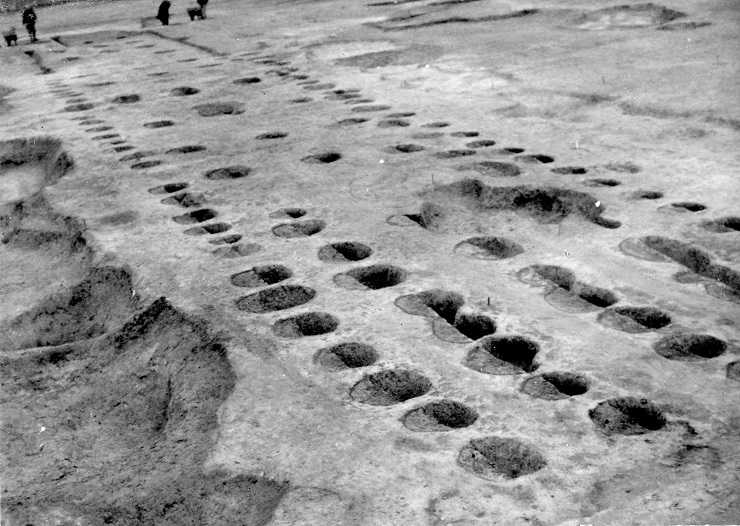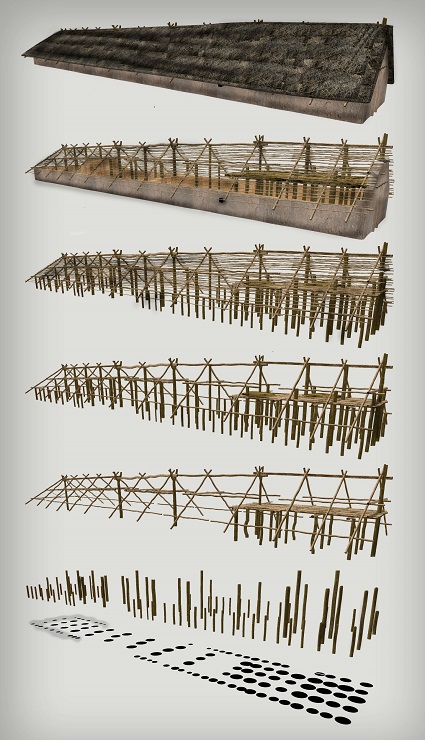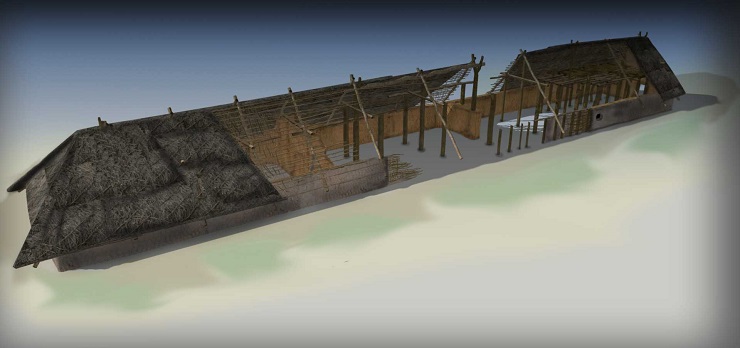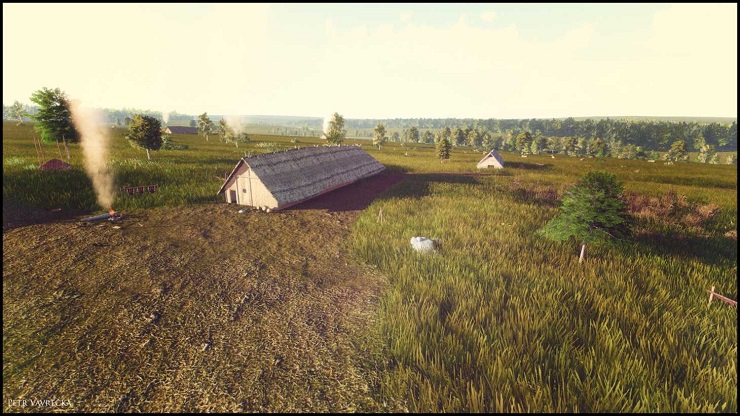The sedentary nature of life attached to a specific area represents a crucial civilisational change that has accompanied humans and their society since the Neolithic era. In its essence it is still valid, even though the nomadic tradition still remains in some cultures. The sedentarisation of communities represents a turning point in a historical period and it is perhaps comparable in its significance only to the industrial revolution. Settling in one place enabled people to build more permanent and stable homes, which can also be considered as being houses in the modern sense. They were therefore spaces that not only provided a certain amount of comfort and a suitable background for both the material and spiritual aspects of human existence, but also a place for production or for storage during unfavourable weather seasons.
 |
| A photograph of the remains of the groundplan of a Neolithic longhouse located at the Bylany site. |
In the wider area of Central Europe Neolithic longhouses have been associated with the first agricultural populations since the time of their inception. Their remarkable unity in the vast space and during the time of the earlier Neolithic period points to the common cultural background of individual communities. The remains of these prehistoric houses are recorded archaeologically, only in the regard to the recessed portions of their groundplans. These in fact represent the negative imprints in the subsoil of base postholes or troughs, in which originally wooden poles were erected. The oldest houses of the Linear Pottery culture accounted for the aboveground structures that consisted of five rows of load-bearing columns. The outer walls of the house were interlaced with wicker and subsequently daubed, using a mixture of clay and such organic ingredients as grass and straw. The centre row and thee two inner rows of posts propped-up the roof truss and the purlins. The timber components of the preserved Neolithic wells manifest the skills and the sophistication of their carpentry joints (i.e. tapping and lapping), which were undoubtedly also applied during the construction of the houses. The roof could be covered either with the split parts of logs or with bark or reeds or thatched straw.
 |
| A hypothetical reconstruction of a longhouse of the Linear Pottery culture based on plan No. 41 from Bylany. Author Petr Vavrečka. |
The hallmark of Neolithic houses is their considerable length (of up to 48 m) and their rectangular groundplans with an approximate north-south orientation. Because of this they are easily recognisable even in a tangle of postholes on the settlement. Also typical of these oldest houses are the large construction pits that are located along both of the longer sides of the house, which represented a source of the clay that was needed for daubing the walls. Within the entire range of LBK culture houses smaller one-section houses are known, but then so also are three-section houses. It is expected that the length of the house should reflect not only the number of its inhabitants and their social status, but some evidence also suggests that it could represent communities that have divergent subsistence strategies.
It is difficult to define the functions of the individual sections of the house (whether they are southern, central or northern) based on the finding situation, because there are no available floor horizons and therefore there is also almost no information about the interiors or the amenities of the dwelling. Probably the original floor level was located a few feet higher, but it was removed by soil erosion and agricultural activities during the course of the millennia. Direct evidence that would enable some assessment of the activities that took place inside the house is virtually absent. A unique example of the interior fittings is the recessed silo located in the southeast corner of the central part of the groundplan of a house in Bylany, close to Kutná Hora. The layout of the longhouse is therefore sometimes interpreted on the basis of ethnographic evidence. Emphasis is placed on increasing the intimacy of the space along its longitudinal axis from the southern entrance to the house towards the north. The southern part is looked upon as being a working and/or a storage space, while the central part is considered to be the residential are and the social nucleus that was centred around the expected heating system (i.e. a fireplace or a furnace) and the northern part of the house is considered as private space.
At one stage of a settlement there were usually about five houses that functioned together, but sometimes there were more than ten. Solitary houses are found rather rarely; for example there is one on the site in Miskovice. It is generally believed that the houses provided facilities for one- or two-generation families. Demographic estimates in regard to the population of the settlements vary considerably, ranging between 25 and 150-250. The number of the sections of the house has inevitably been associated with the number of its inhabitants and also, in particular, with their position in society. This would suggest a certain degree of structuring of the settlement, which would also be reflected in the types of houses that differed in accordance with the number and the combination of their individual sections.
 |
| A hypothetical reconstruction of a Neolithic longhouse with an elevated floor in its southern section. Author Petr Vavrečka. |
 |
| Longhouses were grouped in settlements, which could take the form of several individual freestanding houses, as in the picture, or perhaps in even more organised settlements with houses standing in rows. Author Petr Vavrečka. |
Want to learn more?
- Coudart, A. 1998. Architecture et société néolithique. L´unité et la variance de la maison danubienne. Paris.
- Modderman, P. J. R. 1970. Linearbandkeramik aus Elsloo und Stein. Analecta Praehistorica Leidensia 3.
- Pavlů, I. 2000. Life on a neolithic site. Praha, ARU Praha.
- Podborský, V. 2011. Fenomén neolitického domu. Sborník prací Filozofické fakulty Brněnské univerzity. Studia Minora Facultatis Philosophicae Universitatis Brunensis 2009-2010(M 14-15): 17-45.
- Rück, O. 2009. New aspects and models for Bandkeramik settlement research. Creating communities . New advances in Central European Neolithic research. D. Hofmann and P. Bickle, Oxbow books: 159-185.
- Soudský, B. 1969. Étude de la maison néolithique. Slovenská archeológia 17: 5-96.
- Stäuble, H. 2005. Häuser and absolute Datierung der Ältesten Bandkeramik. Bonn, Dr. Rudolf Habelt GmbH.
- Whittle, A. 2009. The people who lived in longhouses: what´s the big idea? Creating Communities. New Advances in Central European Neolithic Research. D. Hofmann and P. Bickle. Oxford, Oxbow Books: 249-263.
 Archeologické 3D virtuální muzeum
Archeologické 3D virtuální muzeum

.png)